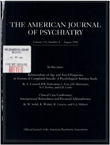Difference between plasma N- and C-terminally directed beta-endorphin immunoreactivity in infantile autism
Abstract
OBJECTIVE: The authors investigated whether there is excessive opioid activity in infantile autism by measuring plasma beta-endorphin in patients with autism compared with patients who had Rett's syndrome and normal comparison subjects. METHODS: Radioimmunoassays for beta- endorphin using C-terminally and N-terminally directed antisera were applied to plasma samples from 67 children who met both DSM-III-R and ICD-10 diagnostic criteria for infantile autism, 22 girls with Rett's syndrome, and 67 normal children matched in age and sex with the children with autism. RESULTS: Median N-terminally directed beta- endorphin immunoreactivity appeared to be slightly lower in subjects with autism (7 pg/ml) and clearly higher in the girls with Rett's syndrome (40 pg/ml) than in the comparison subjects (9 pg/ml). Median C- terminally directed beta-endorphin immunoreactivity was higher in the girls with Rett's syndrome (35 pg/ml) and much higher in patients with autism (70 pg/ml) than in comparison subjects (8 pg/ml). CONCLUSIONS: These findings demonstrate the existence of a wide discrepancy between C- and N-terminally directed beta-endorphin immunoreactivity among children with autism. Despite the fact that the nature of the antigen recognized in the plasma of autistic children by the C-terminally directed anti-beta-endorphin serum remains to be characterized, the difference between C- and N-terminally directed beta-endorphin immunoreactivity might suggest an abnormal processing of the pro- opiomelanocortin gene in infantile autism.
Access content
To read the fulltext, please use one of the options below to sign in or purchase access.- Personal login
- Institutional Login
- Sign in via OpenAthens
- Register for access
-
Please login/register if you wish to pair your device and check access availability.
Not a subscriber?
PsychiatryOnline subscription options offer access to the DSM-5 library, books, journals, CME, and patient resources. This all-in-one virtual library provides psychiatrists and mental health professionals with key resources for diagnosis, treatment, research, and professional development.
Need more help? PsychiatryOnline Customer Service may be reached by emailing [email protected] or by calling 800-368-5777 (in the U.S.) or 703-907-7322 (outside the U.S.).



